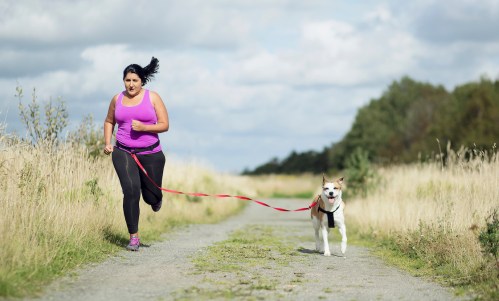Our editors independently select these products. Making a purchase through our links may earn Well+Good a commission
You know that feeling of satisfied exhaustion that comes after a good run? Well, turns out, your dog has the chance to feel that, too.
Experts in This Article
Dog running expert, co-founder of D.C. Dog Runner, and author of ‘The Ultimate Guide to Running with Your Dog.’
Dog running expert and owner of Philly Fit Dog.
Taking dogs for a run is an effective and fun way to get some exercise for you and your pooch. The well-known benefits of going for a jog are both physical and mental: It’s a great form of aerobic exercise that will help you build endurance, and it will boost your mood and help you sleep better. The same is true for dogs.
“They can release whatever that pent up energy is, and whatever is causing it,” says Bryan Barrera, who has his own dog-running service in Washington, DC, and who wrote The Ultimate Guide to Running With Your Dog. “You just get a sense that they’re more at peace.”
Barrera and Philadelphia-based professional dog runner Whitney Wells both say that running can help your dog harness their energy into something productive, and that giving them something to focus on can even help reduce anxiety.
“They’re getting a workout for their brain as well as their body,” Wells says.
Who wouldn’t want a happier, more stimulated and satisfied pup? In particular, dogs with excess energy, dogs with anxiety, or those who are chewing up items at home might all benefit from the extra exercise. But whether or not you’re a runner yourself, going out for your first dog run might feel intimidating. Luckily, Barrera and Wells filled us in on what it takes.
How should I start running with my dog?
If it’s your dog’s first time out for a jog, Barrera says you want to start them on a training plan in a similar way that you would for humans, “like a doggy couch-to-5K.”
“You’ll want to sort of introduce the activity of running,” Barrera says. “Building them up is always key.” He recommends beginning with running-walking intervals for about 20 to 30 minutes at a time, a few times a week, until you’re both used to running together.
How do I know if my dog is a good candidate for a run?
Barrera notes that dogs are natural runners, and that most should be able to run if they’re in good health. “All dogs can run,” he says. “It’s our job to figure out how far and how fast.”
That said, if yours is a young puppy or a more senior dog, Wells notes that it might be a good idea to check with your vet first.
What gear do I need to get started?
Despite the fact that expensive gear abounds for dog running, neither dog runner says there’s a must-have product you need to get before you get out on the road. Instead, they say to play around with whatever feels safest and most comfortable for you. For example, Wells likes a bungee waist belt, like this one on Amazon, because she feels attaching her dog to her center of gravity gives her more control than holding a leash in her hand. However, Barrera likes to go with just a leash and a harness, like the PetSafe Gentle Leader.
“The tools that give you confidence to get a situation under control are the best tools for you,” Barrera says. (He advises against extendable leashes.)
But it might be a good idea to have a dedicated leash or harness just for running, Barrera says. That gives a signal to your dog that you’re about to go for a run, and prepares them for what they’re about to do. Wearing saddle bags or another sort of water vest, like this one from Ruffwear, can also help give your dog purpose and tune into the task at hand in a more focused way.
How do I make sure both my dog and I are having a safe, fun time?
It’s important to make sure the conditions are right for running with your dog. If it’s been snowing, the salt on the ground might not bother your sneakered feet, but it could hurt your dog’s paws. The same goes with hot sidewalks: Even if the air has cooled down, the concrete might be retaining heat in a way that will be uncomfortable. Feel the pavement first before taking your dog out.
You’ll also want to pay attention to cues from your dog. Barrera says to look out for a tongue lolling to the side: That’s a sign that your dog is too hot and tired, and needs a break.
“Dogs get dehydrated faster than we do,” Wells says. Always bring water along on a run, and be prepared to take breaks (even if it impacts your mile time).
“They’re going to do everything that you asked them to do,” Barrera says. “So it’s really up to us to check on these non-verbal communication [signs] they’re giving us to make sure that they’re still in a good spot.”
What else should I keep in mind?
Starting out running with dogs can be a bit choppy. Maybe they haven’t realized they’re in a different mode, so they still want to chase that squirrel, or go say hi to another dog. Both dog runners advise patience, and Wells says that things will likely improve as you get further into the run.
“Once we start moving, they get into a better rhythm of it all,” Wells says.
And as you’re both learning to run together, Barrera says to adjust your expectations for runs. You might have to forego hitting a personal best mile time so both you and your pooch can have a good time. “The center of that run, especially when you’re learning how your dog responds to running, should be the dog,” Barrera says.
But eventually, there will be a benefit to both of you.
“It’s fun to have a running companion,” Wells says. “You may not be going as fast and hitting those mile marks at the pace that you usually do, but you’re getting to run with this cute little furry guy next to you. So it’s a tradeoff, but then you get to benefit from a happy and tired dog at home.”
Sounds good to us.
Oh hi! You look like someone who loves free workouts, discounts for cutting-edge wellness brands, and exclusive Well+Good content. Sign up for Well+, our online community of wellness insiders, and unlock your rewards instantly.
Sign Up for Our Daily Newsletter
Get all the latest in wellness, trends, food, fitness, beauty, and more delivered right to your inbox.
Got it, you've been added to our email list.











